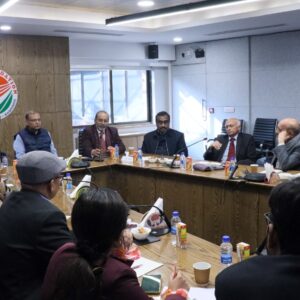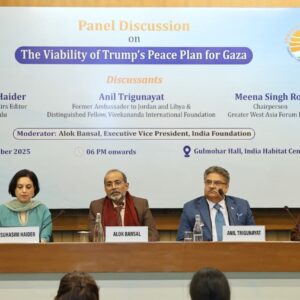If India and its neighbourhood are to be summed up in one sentence, it would be ‘uncertain terrestrial and uneasy maritime neighbours’. A closer look at each is necessary.
Bangladesh has experienced turbulence over the past year since PM Sheikh Hasina was ousted in a so-called student agitation. The army facilitated her safe exit to India, where she has remained. How Prof Yunus Mohammed, a Nobel laureate, was appointed as an Advisor to an unconstitutional government comprising six Advisors makes it clear that the entire regime change was orchestrated by a major power’s deep state—a combination of foreign service and intelligence agency.
The events leading up to the downfall of the Sheikh Hasina regime highlight US concerns about China’s growing influence in the region, which could provide easier access to the Bay of Bengal. The PRC already exerts significant influence over the Junta in Myanmar, as well as the warring factions. It may be noted that China has operational control of Kyaukphu deep-sea port (located in Rakhine State and under the control of one of the warring factions), which China uses to offload Gulf crude for further transport to the oil refinery in Kunming. The port also functions as a key hub for managing container traffic from China.
The Bay of Bengal gives China access to the adjoining Indian Ocean without needing to navigate through the Straits of Malacca. The Chinese have long seen passage through the Malacca Straits as their vulnerability due to the threat of interdiction by the US and Indian navies during periods of increased tension. Hu Jintao called it the ‘Malacca Dilemma’. To challenge the Chinese, the US aimed to control Bangladesh’s St Martin’s Island, located a few miles from Myanmar. Sheikh Hasina’s refusal to agree to this demand was possibly one of the reasons behind the regime change in Bangladesh.
Post-Hasina, law and order have deteriorated significantly in Bangladesh. Large-scale killings of minority Hindus, Christians, and Sikhs have alarmed the world, particularly India. Mass migration across the porous India-Bangladesh border has compelled India to tighten border controls. Additionally, Advisor Yunus has started engaging with China and Pakistan. Chinese engineers have surveyed an abandoned airfield at Lalmunir Hat (about 135 km from the Chicken’s Neck area) for development into a fully operational airport. This could pose a security threat to India. Recently, a Pakistani general declared that they will negotiate with Bangladesh and open another front against India in the eastern theatre.
The great power competition is emerging in the Bay of Bengal region, which has so far been free from any geopolitical contestation. This could limit the Indian Navy’s operations and DRDO’s missile programme, which might come under surveillance.
That brings us to three northern neighbours, Bhutan, Nepal and the Tibet Autonomous Region (under Chinese occupation). Bhutan is a nascent democracy which shares borders with Tibet, Nepal and India. There have been some attempts by the PLA resorting to salami slicing into Indian territory through the Bhutan border, with Doklam being one such example in recent times. Bhutan has also been under pressure from China to cede some part of its northern forested territory, claiming historic rights.
Politically, Bhutan is a fledgling democracy; as such, some political parties, when in power, tend to hedge between India and China. China’s economic coercion and inducements of individual graft are effective in South Asia. The supreme authority lies with HRH the King of Bhutan, who understands geopolitics quite well and has avoided any decisions that could pose a security threat to India, which has traditionally supported Bhutan’s economic development. The Indian government regards Bhutan as its closest ally and has been supporting its education, power generation, and tourism sectors, helping it attain self-sufficiency.
Nepal is somewhat unique. Historically, some political parties in power have balanced between India and China to get the best advantages from both, despite India’s strong support in various aspects of Nepal’s development. Sectors such as tourism, transport, culture, religion, education, security, training, access to maritime trade, and oil supply are areas of close cooperation. Cultural and religious ties, along with a large Indian-origin population, in the Terai region, lead to cross-border marriages. The borders have generally remained open, and the border security forces on both sides maintain very friendly relations.
On the maritime front, India has two neighbours: Sri Lanka and the Maldives. Sri Lanka is a long-established democracy with a multiparty parliament. It has a directly elected President who wields almost all executive power. However, some issues require parliamentary approval, which the Prime Minister oversees. Much of its foreign policy is based on its understanding of geopolitical realities. The country has been observed hedging between India and China at times. Given its strategic location in the Indian Ocean and China’s energy security concerns, appeasing Sri Lanka remains a central aspect of the PRC’s foreign policy.
Under the guise of development, China has invested substantial sums in Sri Lanka, mainly through large loans for infrastructure projects. Overestimating its repayment ability, Sri Lanka has fallen into a debt trap. Consequently, public unrest emerged, leading to the president fleeing the country. An interim government was established under the leadership of HE Ranil Wickremesinghe as the consensus candidate. India stepped in to provide a loan or aid of approximately $3.3 billion, and many economic reforms were introduced. The economy appears to have stabilised. Chinese debt for equity also resulted in the leasing of Hambantota and Colombo South ports to China. It has been noted that, although China generally utilises these ports for commercial purposes, warships, submarines, and ocean survey ships occasionally use them, raising security concerns for India. The PLAN shipborne radars can monitor India’s maritime activities and missile developments. When considered alongside China’s recent attempts to ingress the Bay of Bengal via land routes through Bangladesh and Myanmar, it does not bode well for India.
The Maldives is another neighbour with a developing democracy. Having transitioned from Abdul Gayum’s dictatorship, Mr. Nasheed was elected as the first President. His approach to India was that of a friendly neighbour. India responded positively by providing developmental aid and essentials to remote islands. Given the Maldives’ geographical location, India is very significant. China saw an opportunity for economic coercion by offering large sums and faster developmental infrastructure work. Gradually, Chinese influence began to grow and aligned with the String of Pearls concept, which involves encircling India with Chinese-influenced states for long-term strategic advantage. Indian contractor GMR was asked to leave even before its contract expired. Clearly, the future of India-Maldives relations requires reconsideration.
Following the general elections, Mr Yameen came to power, and his inclination towards the PRC was well known. Although he made prudent diplomatic moves to convince India that the Maldives was its closest friend and a good neighbour, his policies were pro-China. There came a point when a specific island, which was nearest to India’s Minicoy island, was being leased to China. This caused concern in South Block, prompting senior Indian diplomats to travel to Male and express India’s serious concerns. Crossing the red line was not expected from a neighbouring state. The remaining five years under Yameen’s presidency remained challenging. Nonetheless, India maintained its friendly stance and honoured all commitments. The next election cycle resulted in a government led by Mr Solih, who was optimistic about India’s contribution to its development. However, five years later, Coalition candidate Mr Moizzu won the election on the slogan of ‘India Out’. The clear direction of his policies was towards closeness to the PRC. He observed protests on the streets by people demanding closer ties with India. This was followed by two or three severe shortages in the country, which were addressed with equal urgency by New Delhi. The President recognised the importance of India and its stature in the public eye. He called on the Prime Minister in Delhi to reset the relations and withdrew most of the proposals that were pending approval for the PRC.
Overall, there has been a fluctuating cycle of alliances. The Government of India has upheld its supportive stance, honouring every agreement and signing new ones. China’s influence operation is likely to continue as part of its foreign policy.
India’s immediate neighbourhood narrative cannot be complete without reflecting upon the most irritating neighbour, Pakistan. Born out of the two-nation theory, Pakistan is yet to find itself. Currently, the country is struggling with financial problems. Yet, it continues to harbour terrorist organisations that have been the source of terrorism worldwide. To annexe the Indian state of Jammu and Kashmir, Pakistan has launched a low-intensity conflict using terrorist groups. It has practised bleeding India with a thousand cuts. On several occasions, this has escalated into a full-fledged war.
In 1971, when India intervened in East Pakistan, the region was under martial law and subjected to repression of Bengali-speaking citizens. That war led to the disintegration of Pakistan and the creation of Bangladesh. Since the current government led by Shri Narendra Modi came to power in 2014, India has responded to cross-border terrorism with military actions against known terrorist camps in Pakistan-occupied Kashmir (PoK). Terror incidents in J&K have been met with military responses across the border. There is substantial evidence that the Pakistan Army and its intelligence agency, ISI, are the main perpetrators of terrorism, financing terror groups to attack innocent civilians in J&K. Most recently, 26 innocent tourists were killed in Pahalgam. India responded through Operation Sindoor, striking at the heart of the terror network in Pakistan and causing severe damage to Pakistan’s air defence capabilities. Having achieved its objectives, India accepted Pakistan’s request for a ceasefire. However, India has made it clear that, henceforth, any terrorist attack will be treated as war and responded to accordingly.
India’s immediate neighbourhood is anything but peaceful. Maintaining peace to enable India’s growth story will remain the defining challenge of the coming decade.
Author Brief Bio: Vice Admiral Shekhar Sinha was the Commander in Chief of the operationally active Western Naval Command, responsible for maritime security of Sea Lanes of Communication in Arabian Sea and both, Gulf of Aden and Persian Gulf. Prior to assuming this assignment he was Chief of Integrated Defense Staff to Chiefs of Staff committee. He has been awarded the ParamVishishth and AtiVishishthSewa Medal for exceptional service to the Navy. He has also been conferred with two Gallantry awards.





